Abstract
1 Splanchnic artery occlusion (SAO) shock is characterized by irreversible circulatory failure. Tumour necrosis factor (TNF-α) may affect the L-arginine/nitric oxide (NO) pathway, thus contributing to the cardiovascular derangements of circulatory shock.
2 We investigated the contribution of both TNF-α and the L-arginine/nitric oxide pathway to the vascular dysfunction of SAO shock. Anaesthetized rats, subjected to total occlusion of the superior mesenteric artery and the coeliac trunk for 45 min developed a severe shock state (SAO shock) resulting in a fatal outcome within 75-90 min after the release of occlusion. Sham operated animals were used as controls. SAO shocked rats had also a marked hypotension and enhanced macrophage and serum levels of TNF-α. Furthermore, aortic rings from shocked rats showed a marked hyporeactivity to phenylephrine (PE 1 nM—10 μM) and reduced responsiveness to acetylcholine (ACh 10 nM—10 μM). Endotheliumdenuded aortic rings had also a marked hyporeactivity to phenylephrine, which was restored to control values by in vitro administration of NG nitro-L-arginine-methyl ester (L-NAME 10 μM).
3 In vivo administration of cloricromene (2 mg kg-1, i.v.), an inhibitor of TNF-α biosynthesis, increased survival, enhanced mean arterial blood pressure and reduced macrophage and serum levels of TNF-α. Furthermore, aortic rings from shocked rats treated with cloricromene exhibited a greater contractile response to phenylephrine and improved responsiveness to ACh when compared to aortic rings from vehicle-treated SAO shocked rats.
4 Our results suggest that TNF-α alters both endothelial and muscular L-arginine/nitric oxide pathways which in turn produce vascular dysfunction in SAO shock.
Keywords: Cytokine, impaired vascular reactivity, endothelium, L-arginine-NO pathway
Full text
PDF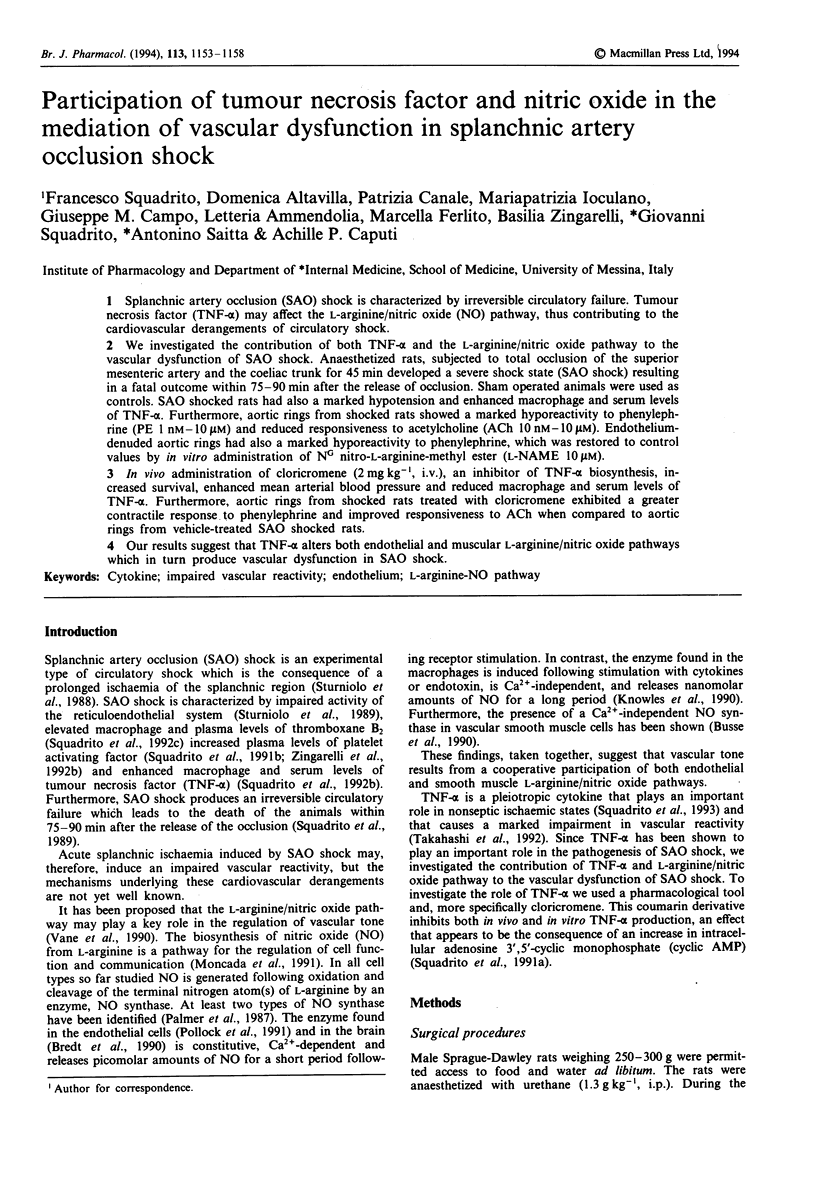
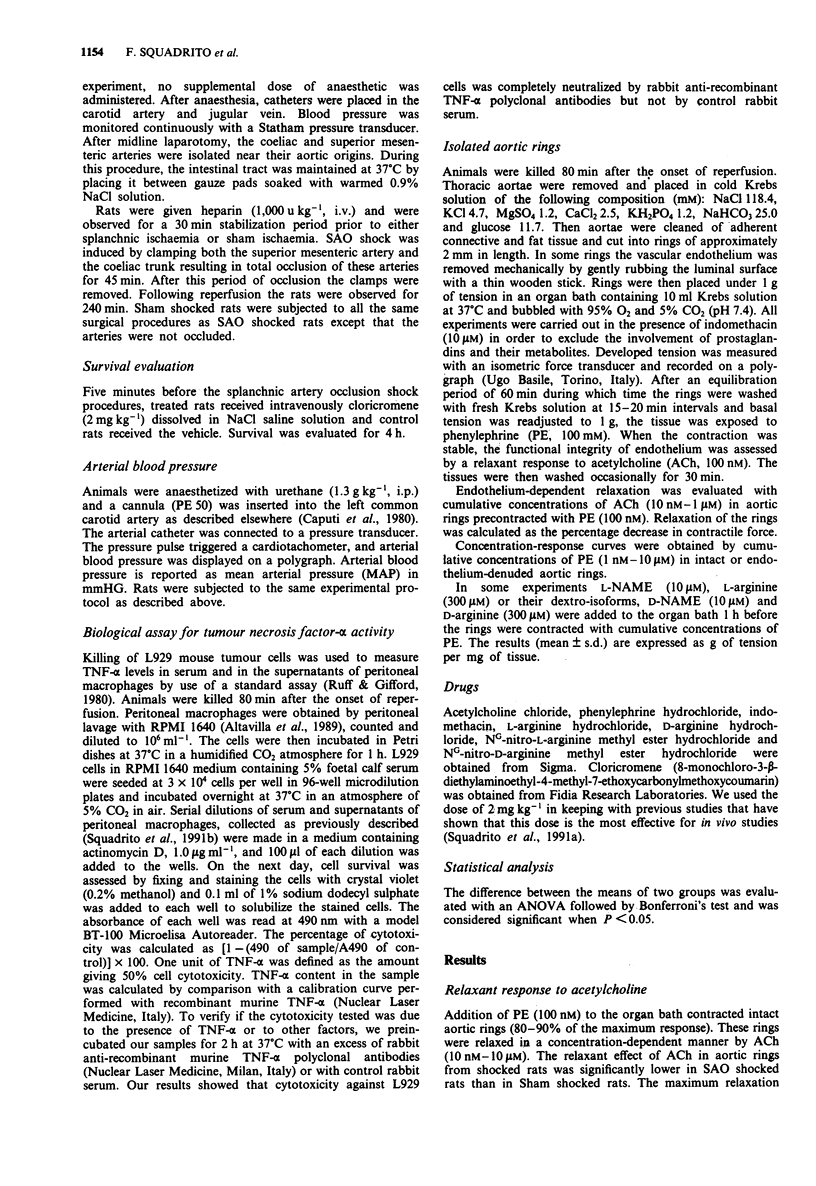
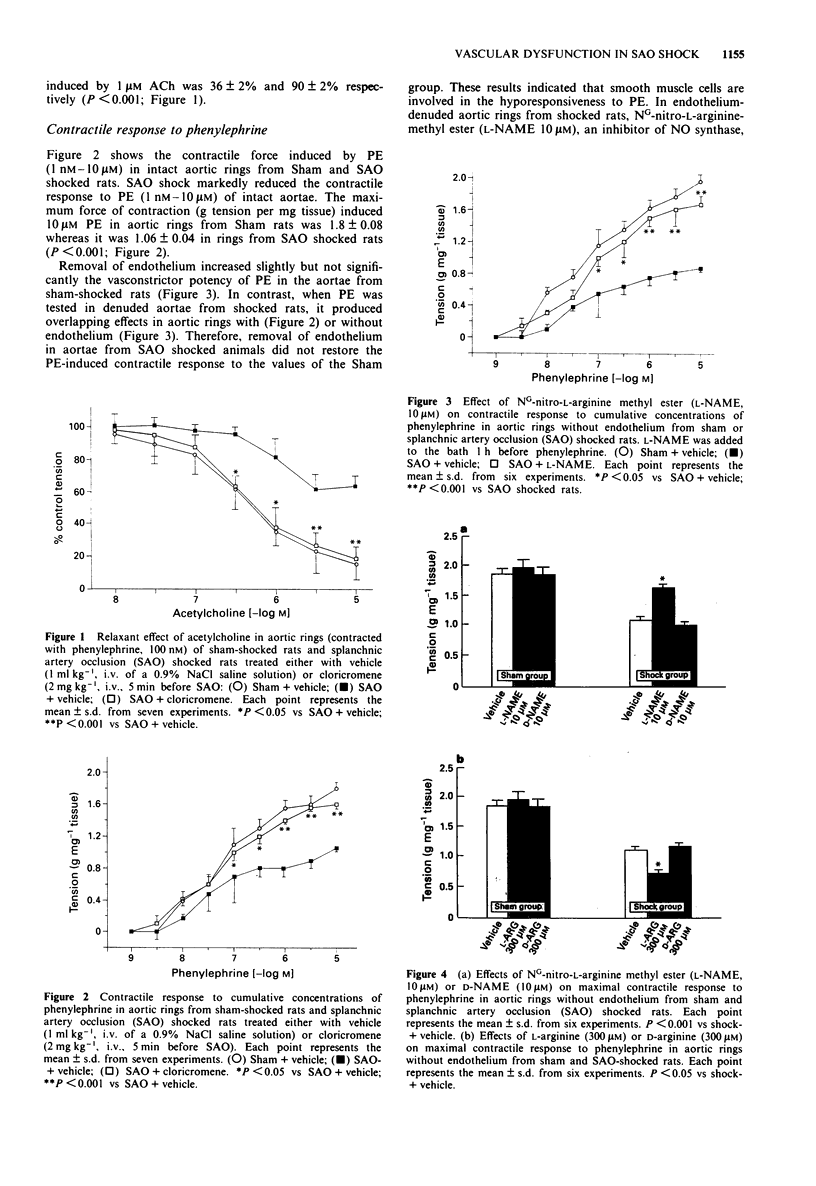
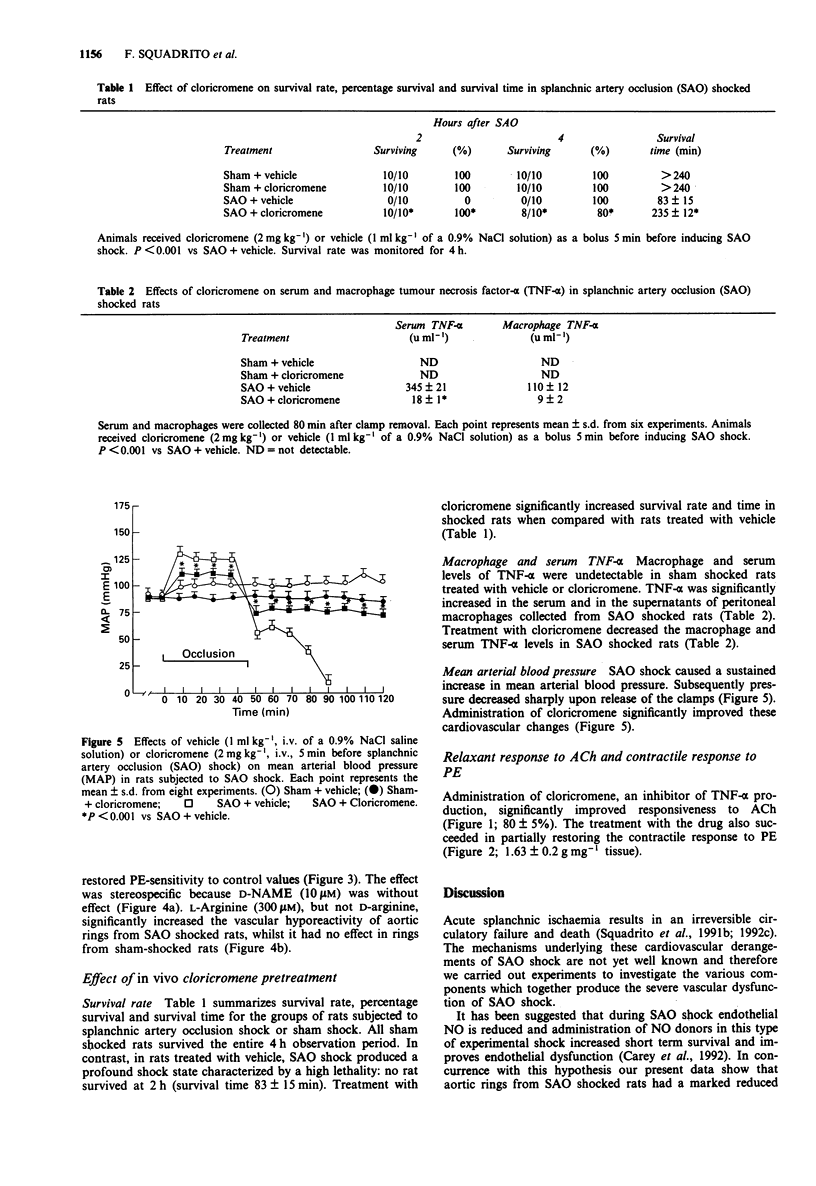
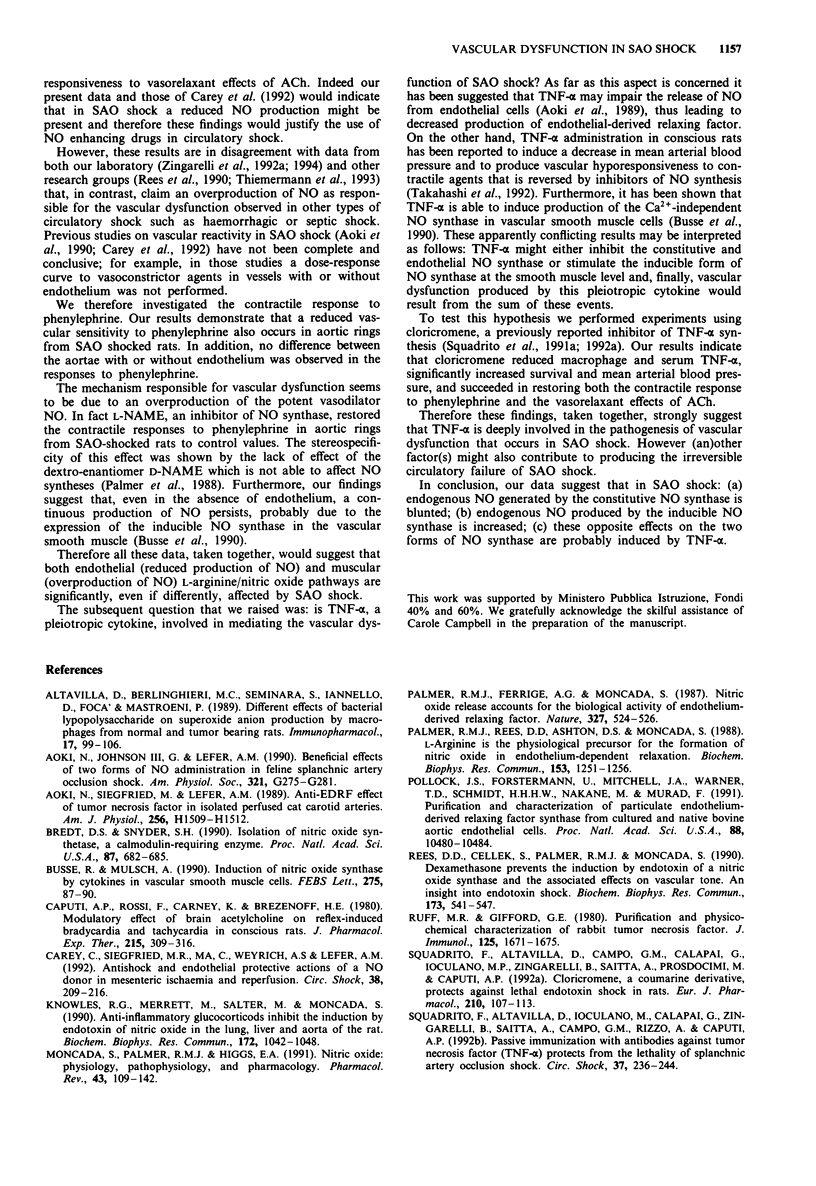
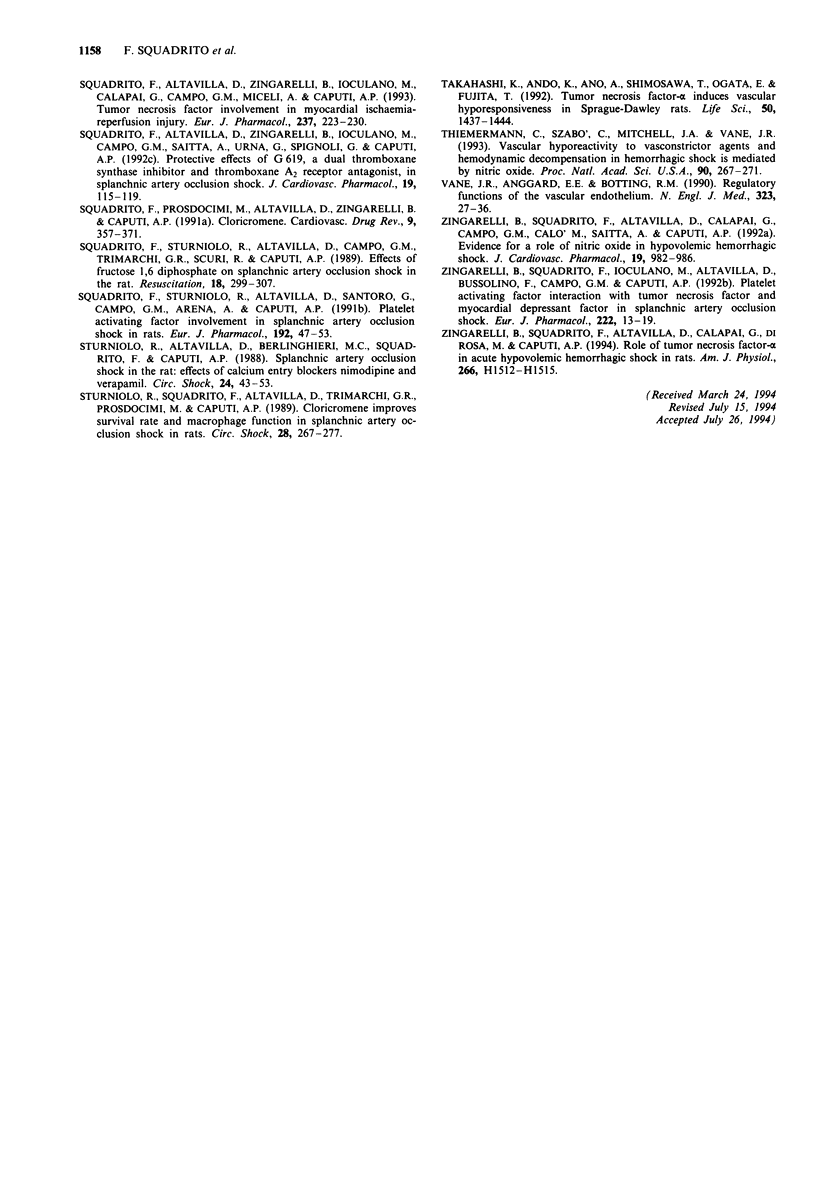
Selected References
These references are in PubMed. This may not be the complete list of references from this article.
- Altavilla D., Berlinghieri M. C., Seminara S., Iannello D., Focà A., Mastroeni P. Different effects of bacterial lipopolysaccharide on superoxide anion production by macrophages from normal and tumor-bearing rats. Immunopharmacology. 1989 Mar-Apr;17(2):99–106. doi: 10.1016/0162-3109(89)90055-6. [DOI] [PubMed] [Google Scholar]
- Aoki N., Johnson G., 3rd, Lefer A. M. Beneficial effects of two forms of NO administration in feline splanchnic artery occlusion shock. Am J Physiol. 1990 Feb;258(2 Pt 1):G275–G281. doi: 10.1152/ajpgi.1990.258.2.G275. [DOI] [PubMed] [Google Scholar]
- Aoki N., Siegfried M., Lefer A. M. Anti-EDRF effect of tumor necrosis factor in isolated, perfused cat carotid arteries. Am J Physiol. 1989 May;256(5 Pt 2):H1509–H1512. doi: 10.1152/ajpheart.1989.256.5.H1509. [DOI] [PubMed] [Google Scholar]
- Bredt D. S., Snyder S. H. Isolation of nitric oxide synthetase, a calmodulin-requiring enzyme. Proc Natl Acad Sci U S A. 1990 Jan;87(2):682–685. doi: 10.1073/pnas.87.2.682. [DOI] [PMC free article] [PubMed] [Google Scholar]
- Busse R., Mülsch A. Induction of nitric oxide synthase by cytokines in vascular smooth muscle cells. FEBS Lett. 1990 Nov 26;275(1-2):87–90. doi: 10.1016/0014-5793(90)81445-t. [DOI] [PubMed] [Google Scholar]
- Caputi A. P., Rossi F., Carney K., Brezenoff H. E. Modulatory effect of brain acetylcholine on reflex-induced bradycardia and tachycardia in conscious rats. J Pharmacol Exp Ther. 1980 Nov;215(2):309–316. [PubMed] [Google Scholar]
- Carey C., Siegfried M. R., Ma X. L., Weyrich A. S., Lefer A. M. Antishock and endothelial protective actions of a NO donor in mesenteric ischemia and reperfusion. Circ Shock. 1992 Nov;38(3):209–216. [PubMed] [Google Scholar]
- Knowles R. G., Salter M., Brooks S. L., Moncada S. Anti-inflammatory glucocorticoids inhibit the induction by endotoxin of nitric oxide synthase in the lung, liver and aorta of the rat. Biochem Biophys Res Commun. 1990 Nov 15;172(3):1042–1048. doi: 10.1016/0006-291x(90)91551-3. [DOI] [PubMed] [Google Scholar]
- Moncada S., Palmer R. M., Higgs E. A. Nitric oxide: physiology, pathophysiology, and pharmacology. Pharmacol Rev. 1991 Jun;43(2):109–142. [PubMed] [Google Scholar]
- Palmer R. M., Ferrige A. G., Moncada S. Nitric oxide release accounts for the biological activity of endothelium-derived relaxing factor. Nature. 1987 Jun 11;327(6122):524–526. doi: 10.1038/327524a0. [DOI] [PubMed] [Google Scholar]
- Palmer R. M., Rees D. D., Ashton D. S., Moncada S. L-arginine is the physiological precursor for the formation of nitric oxide in endothelium-dependent relaxation. Biochem Biophys Res Commun. 1988 Jun 30;153(3):1251–1256. doi: 10.1016/s0006-291x(88)81362-7. [DOI] [PubMed] [Google Scholar]
- Pollock J. S., Förstermann U., Mitchell J. A., Warner T. D., Schmidt H. H., Nakane M., Murad F. Purification and characterization of particulate endothelium-derived relaxing factor synthase from cultured and native bovine aortic endothelial cells. Proc Natl Acad Sci U S A. 1991 Dec 1;88(23):10480–10484. doi: 10.1073/pnas.88.23.10480. [DOI] [PMC free article] [PubMed] [Google Scholar]
- Rees D. D., Cellek S., Palmer R. M., Moncada S. Dexamethasone prevents the induction by endotoxin of a nitric oxide synthase and the associated effects on vascular tone: an insight into endotoxin shock. Biochem Biophys Res Commun. 1990 Dec 14;173(2):541–547. doi: 10.1016/s0006-291x(05)80068-3. [DOI] [PubMed] [Google Scholar]
- Ruff M. R., Gifford G. E. Purification and physico-chemical characterization of rabbit tumor necrosis factor. J Immunol. 1980 Oct;125(4):1671–1677. [PubMed] [Google Scholar]
- Squadrito F., Altavilla D., Campo G. M., Calapai G., Ioculano M., Zingarelli B., Saitta A., Prosdocimi M., Caputi A. P. Cloricromene, a coumarine derivative, protects against lethal endotoxin shock in rats. Eur J Pharmacol. 1992 Jan 14;210(2):107–113. doi: 10.1016/0014-2999(92)90660-v. [DOI] [PubMed] [Google Scholar]
- Squadrito F., Altavilla D., Ioculano M., Calapai G., Zingarelli B., Saitta A., Campo G. M., Rizzo A., Caputi A. P. Passive immunization with antibodies against tumor necrosis factor (TNF-alpha) protects from the lethality of splanchnic artery occlusion shock. Circ Shock. 1992 Jul;37(3):236–244. [PubMed] [Google Scholar]
- Squadrito F., Altavilla D., Zingarelli B., Ioculano M. P., Campo G. M., Calapai G., Saitta A., Urna G., Sardella A., Spignoli G. Protective effects of G 619, a dual thromboxane synthase inhibitor and thromboxane A2 receptor antagonist, in splanchnic artery occlusion shock. J Cardiovasc Pharmacol. 1992 Jan;19(1):115–119. doi: 10.1097/00005344-199201000-00016. [DOI] [PubMed] [Google Scholar]
- Squadrito F., Altavilla D., Zingarelli B., Ioculano M., Calapai G., Campo G. M., Miceli A., Caputi A. P. Tumor necrosis factor involvement in myocardial ischaemia-reperfusion injury. Eur J Pharmacol. 1993 Jun 24;237(2-3):223–230. doi: 10.1016/0014-2999(93)90272-j. [DOI] [PubMed] [Google Scholar]
- Squadrito F., Sturniolo R., Altavilla D., Campo G. M., Trimarchi G. R., Scuri R., Caputi A. P. Effects of fructose 1,6-diphosphate on splanchnic artery occlusion shock in the rat. Resuscitation. 1989 Dec;18(2-3):299–307. doi: 10.1016/0300-9572(89)90030-0. [DOI] [PubMed] [Google Scholar]
- Squadrito F., Sturniolo R., Altavilla D., Santoro G., Campo G. M., Arena A., Caputi A. P. Platelet activating factor involvement in splanchnic artery occlusion shock in rats. Eur J Pharmacol. 1991 Jan 3;192(1):47–53. doi: 10.1016/0014-2999(91)90067-z. [DOI] [PubMed] [Google Scholar]
- Sturniolo R., Altavilla D., Berlinghieri M. C., Squadrito F., Caputi A. P. Splanchnic artery occlusion shock in the rat: effects of the calcium entry blockers nimodipine and verapamil. Circ Shock. 1988;24(1):43–53. [PubMed] [Google Scholar]
- Sturniolo R., Squadrito F., Altavilla D., Trimarchi G. R., Prosdocimi M., Caputi A. P. Cloricromene improves survival rate and peritoneal macrophage function in splanchnic artery occlusion shock in rats. Circ Shock. 1989 Jul;28(3):267–277. [PubMed] [Google Scholar]
- Takahashi K., Ando K., Ono A., Shimosawa T., Ogata E., Fujita T. Tumor necrosis factor-alpha induces vascular hyporesponsiveness in Sprague-Dawley rats. Life Sci. 1992;50(19):1437–1444. doi: 10.1016/0024-3205(92)90262-n. [DOI] [PubMed] [Google Scholar]
- Thiemermann C., Szabó C., Mitchell J. A., Vane J. R. Vascular hyporeactivity to vasoconstrictor agents and hemodynamic decompensation in hemorrhagic shock is mediated by nitric oxide. Proc Natl Acad Sci U S A. 1993 Jan 1;90(1):267–271. doi: 10.1073/pnas.90.1.267. [DOI] [PMC free article] [PubMed] [Google Scholar]
- Vane J. R., Anggård E. E., Botting R. M. Regulatory functions of the vascular endothelium. N Engl J Med. 1990 Jul 5;323(1):27–36. doi: 10.1056/NEJM199007053230106. [DOI] [PubMed] [Google Scholar]
- Zingarelli B., Squadrito F., Altavilla D., Calapai G., Campo G. M., Calò M., Saitta A., Caputi A. P. Evidence for a role of nitric oxide in hypovolemic hemorrhagic shock. J Cardiovasc Pharmacol. 1992 Jun;19(6):982–986. doi: 10.1097/00005344-199206000-00021. [DOI] [PubMed] [Google Scholar]
- Zingarelli B., Squadrito F., Altavilla D., Calapai G., Di Rosa M., Caputi A. P. Role of tumor necrosis factor-alpha in acute hypovolemic hemorrhagic shock in rats. Am J Physiol. 1994 Apr;266(4 Pt 2):H1512–H1515. doi: 10.1152/ajpheart.1994.266.4.H1512. [DOI] [PubMed] [Google Scholar]
- Zingarelli B., Squadrito F., Ioculano M., Altavilla D., Bussolino F., Campo G. M., Caputi A. P. Platelet activating factor interaction with tumor necrosis factor and myocardial depressant factor in splanchnic artery occlusion shock. Eur J Pharmacol. 1992 Nov 3;222(1):13–19. doi: 10.1016/0014-2999(92)90456-e. [DOI] [PubMed] [Google Scholar]


